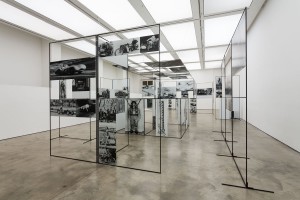Kimberley will attempt to combine her knowledge into contrasting aspects of artistic studies: History of Art and Contemporary Art and Theory. Her challenge = to pick a room of the National Gallery, London at random and find a painting there, whether it be Gothic, Renaissance, Impressionist or Medieval in style, to analyse using contemporary theory.
Can she achieve a deeper level of interpretation? Or will such a random task disintegrate into nonsensical ramblings??  [ “An Old Woman with a Rosary”, Paul Cezanne, 1895 – 1896, oil on canvas, 80.6 x 65.5cm, © National Gallery, London ]
[ “An Old Woman with a Rosary”, Paul Cezanne, 1895 – 1896, oil on canvas, 80.6 x 65.5cm, © National Gallery, London ]
RANDOM ROOM ROULETTE # 9 : ROOM 45 : VAN GOGH & PAUL CEZANNE
“An Old Woman with a Rosary”, Paul Cezanne, 1895 – 1896
You would think the random selection of Room 45, a space smothered with canonical paintings by Van Gogh and Cezanne (the Father of Modern Art) would offer some slight relief for my task in the application of contemporary theory. And whilst the visual ‘modern’ cannot be avoided here, applying contemporary theory is still quite the challenge!
Cezanne’s “An Old woman with a Rosary” captures a lost lady, a wandering, downtrodden nun, with naturalism and honesty. At the time of its creation, this image was revolutionary as it moved away from the idealisation, objectification and sexualisation of the female body prevalent throughout the history of art, towards a realistic identification of the oppression of women. Cezanne’s image is so modern, and does actually succumb to contemporary feminist theory surrounding the depiction of the female figure in art.
Without intention or knowledge of future feminist theories, Cezanne has created an image that is positively enlightening when contemporary theory is applied. His intense realism evokes extreme sadness; the woes of a downcast woman. Cezanne’s use of realism ofcourse conveys truth and objectivity, but when feminist theories are teamed with artist’s intention, the painting can be seen as a portrayal of feminine oppression. This woman is lacking the physical associations of feminity. She is not beautiful, slight, idealised or depicted purely as a realisation of masculine desire. She is not subjected to a scopophilic, sexual male gaze. This alone is rare to see in any image. She still however embodies the beautification rituals or physical associations of what it means to be a woman in her lack. This woman is lacking any kind physical beauty; she is dark, old, bulky, with no visible hair, large clenched fists and a downward stare. Her sadness, oppression and apparent depression or anger is due to her lack. A women is nothing, has nothing to offer except to perform to male sexual gratification. That is a woman’s purpose and objective. In this way Cezanne’s painting is perhaps a realisation of the feminist theories of the 1970’s who infact aimed to convey all of these messages within their work but actually used opposite tactics to do so, such as hyperfeminism, narcissism and the blatant sexual objectification of their own bodies to mimic and critique male domination.
Cezanne’s woman, and still within today’s contemporary society, one that strives for youth, is considered detrimental. She is spent, done, she has nothing left to give as she has lost her looks, her figure and her sexual enigma. This woman is displayed as a shell of a person, due to her age, appearance and sex, wheras a depiction of a male of the same age is likely to have completely different connotations; that of power, intelligence, wealth and the wisdom that comes with age.
Whilst contemporary feminist theories can be loosely applied to any depiction of women or feminity, this application offers relevance. Cezanne lived and worked in a changing artistic and social era, and the delivery of his paintings exhibit this. He was a master among men.
– words by Kimberley Brown






